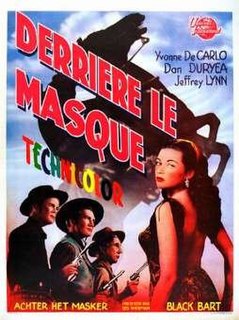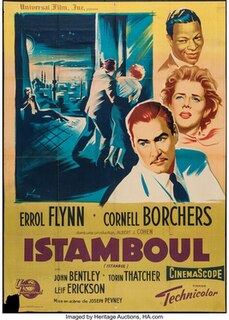
Margaret Yvonne Middleton, known professionally as Yvonne De Carlo, was a Canadian-American actress, dancer and singer. She became a Hollywood film star in the 1940s and 50s, made several recordings, and later acted on television and stage.

Criss Cross is a 1949 American film noir crime film directed by Robert Siodmak and starring Burt Lancaster, Yvonne De Carlo and Dan Duryea, from Don Tracy's novel of the same name. This black-and-white film was shot partly on location in the Bunker Hill section of Los Angeles. The film was written by Daniel Fuchs. Miklós Rózsa scored the film's soundtrack. It was remade as The Underneath in 1995.

Black Bart is a 1948 American Western film directed by George Sherman and starring Yvonne De Carlo, Dan Duryea as the real-life cowboy bandit Charles Bolles, and Jeffrey Lynn. It was distributed by Universal-International and produced by Leonard Goldstein. It was shot in Technicolor and was also known as Black Bart, Highwayman. The film was written by Luci Ward, Jack Natteford, and William Bowers and was released on March 3, 1948.

Helena Carter was an American film actress in the 1940s and 1950s who is best known for her work in the film Invaders from Mars as Dr. Patricia Blake. From 1947 to 1953 she would appear in 13 films, during which time she also worked as a model.

Tomahawk is a 1951 American Western film directed by George Sherman and starring Van Heflin and Yvonne De Carlo. The film is loosely based on events that took place in Wyoming in 1866 to 1868 around Fort Phil Kearny on the Bozeman Trail such as the Fetterman Fight and Wagon Box Fight. In the UK, the film was released as The Battle of Powder River.

The Fighting O'Flynn is a 1949 American adventure film directed by Arthur Pierson. The film's screenplay by Douglas Fairbanks Jr. is based on the novel of the same name by Justin Huntly McCarthy. Fairbanks stars, along with Helena Carter.

Kiss Tomorrow Goodbye is a 1950 film noir starring James Cagney, directed by Gordon Douglas, produced by William Cagney and based on the novel by Horace McCoy. The film was banned in Ohio as "a sordid, sadistic presentation of brutality and an extreme presentation of crime with explicit steps in commission."

Istanbul is a 1957 American CinemaScope film noir crime film directed by Joseph Pevney, and starring Errol Flynn and Cornell Borchers. It is a remake of the film Singapore, with the location of the action moved to Turkey. The plot involves an American pilot who becomes mixed up with various criminal activities in Istanbul.

Something in the Wind is a 1947 American musical comedy film directed by Irving Pichel and starring Deanna Durbin, Donald O'Connor, and John Dall.

Double Crossbones is a 1951 American comedy adventure film distributed by Universal International, produced by Leonard Goldstein, directed by Charles Barton, and stars Donald O'Connor and Helena Carter. It was shot in Technicolor and was released on January 22. The story is of shopkeeper apprentice Davey Crandall becoming a pirate after being accused falsely of being involved of selling stolen goods.

Intrigue is a 1947 American film noir crime film directed by Edwin L. Marin and starring George Raft, June Havoc and Helena Carter. Intrigue was intended to be the first of a number of films Raft made, with producer Sam Bischoff, for his own production company, Star Films. It was one of several movies Raft made with Marin.

Flame of the Islands is a 1956 American film noir crime film directed by Edward Ludwig and starring Yvonne De Carlo, Howard Duff, and Zachary Scott.

Scarlet Angel is a 1952 American Technicolor adventure film directed by Sidney Salkow and starring Yvonne de Carlo and Rock Hudson.
Pirates of Monterey is a 1947 American Technicolor Western film directed by Alfred L. Werker starring Maria Montez and Rod Cameron. It was the last movie she made for Universal.

The Golden Hawk is a 1952 American adventure film, directed by Sidney Salkow and starring Rhonda Fleming and Sterling Hayden, based on the novel of the same name by Frank Yerby.

Calamity Jane and Sam Bass is a 1949 American Western film directed by George Sherman and starring Yvonne de Carlo, Howard Duff and Dorothy Hart.

Frontier Gal is a 1945 American Western film directed by Charles Lamont and starring Yvonne De Carlo and Rod Cameron.

Slave Girl is a 1947 American Technicolor adventure comedy film directed by Charles Lamont and starring Yvonne De Carlo and George Brent.

Time Out of Mind is a 1947 American film noir drama film directed by Robert Siodmak and starring Phyllis Calvert, Robert Hutton and Ella Raines. The film was made by Universal Pictures on a large budget of $1,674,500, but the film was not a commercial success. The British actress Calvert was a major star in Britain and other countries for her roles in the Gainsborough Melodramas.

South Sea Sinner is a 1950 American adventure film directed by H. Bruce Humberstone and starring Macdonald Carey and Shelley Winters. It is a remake of Seven Sinners (1940). Liberace has a small role.



















